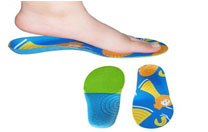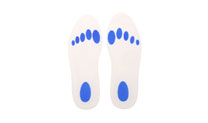The heel is the part of the foot that is most vulnerable to shock and impact stress while walking. For this reason, in many shoes and insole products, vibration-absorbing components are provided in the heel area. The synthetic insole has a polymeric base material and at least one cavity or opening in which one or more gel inserts are placed. Typically, at least one gel insert is placed at the back of the insole located at the heel area of the wearer to absorb vibration from the ground.
The drawback of this construction is that the inserts are small ,which may cause uneven distribution of mechanical properties in the rear and insole, thus affecting the comfort of the wearers. In particular, the transition region between the substrate material and this gel material has different hardness properties. The wearers can feel these transition areas and feel particularly uncomfortable when these transition areas are located at the back of insoles,which are prone to frequent and relatively high stress. For synthetic insoles with gel layers, the upper surface extends roughly through the entire plane of the wearer's feet. It is also set with a covering layer for completely covering the surface of the gel layer, at least the upper surface, to prevent direct contact. The disadvantage of this structure is that the overlay limits the vibration-absorbing properties of the gel layer, thus affecting the comfort level when walking.


